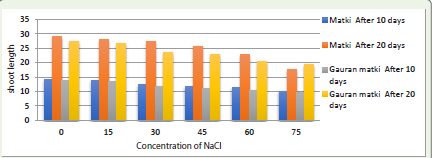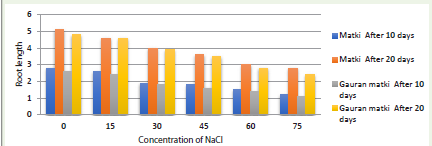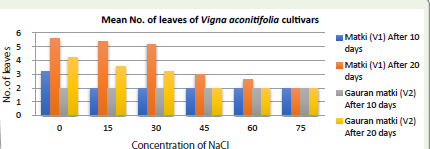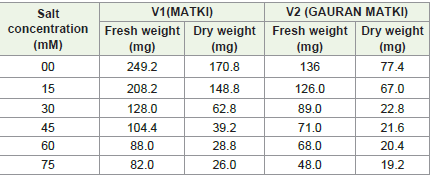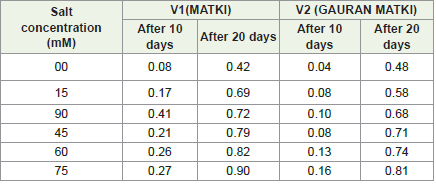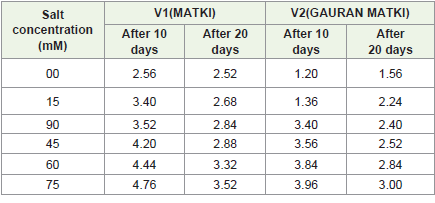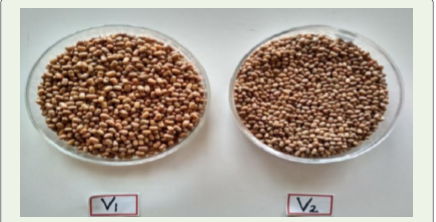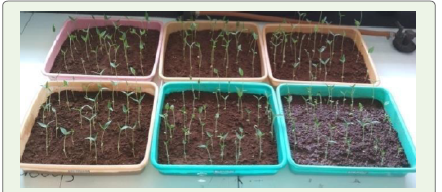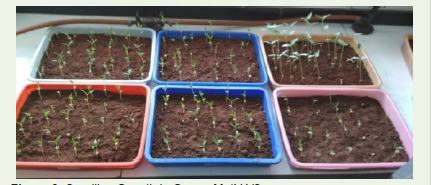Research Article
Multi-Omic Insights into Proline-Mediated Salt Stress Responses in Moth Bean (Vigna aconitifolia): Unraveling Metabolomic and Proteomic Dynamics
Ritu J1* and Uzma A2
Department of Botany, K.M.E. Society’s G.M.Momin Women’s College Bhiwandi, India
*Corresponding author: Ritu Jain, Department of Botany, K.M.E. Society’s G.M.Momin Women’s College Bhiwandi, India. E-mail: ritujain0933@gmail.com
Copyright: © Ritu J, et al. 2023. This is an open-access article distributed under the Creative Commons Attribution License, which permits unrestricted use, distribution, and reproduction in any medium, provided the original work is properly cited.
Article Information: Submission: 07/10/2023; Accepted: 31/10/2023; Published: 06/11/2023
Abstract
The study examines the impact of salinity on two varieties of moth beans (Vigna aconitifolia). Jacq, V1 (Matki) and V2 (Gauranmatki) focus on the morphological parameters, proline, and protein content. Salinity stress is increasingly relevant in the context of climate change and its potential impact on agricultural productivity. We investigate how these two varieties respond to different concentrations of sodium chloride (NaCl) and their suitability for future sustainable agriculture. The accumulation of osmolite compounds is often proposed as a solution to overcome the negative effects of water shortages in
crop production, which is proposed as an adaptive mechanism for drought and salt tolerance. This finding is consistent with what metabolomics studies often reveal. The accumulation of proline is considered an osmoprotective strategy used by plants under osmotic stress conditions, including salinity.
Changes in morphological parameters, including the length of the shoot and root, the number of leaves, and the fresh/dry weight, in response to varying salt concentrations. Proteomic analyses reveal how the expression of specific proteins changes in response to salt stress, providing insights into the molecular
adaptations that enable plants to tolerate salt. Meanwhile, metabolomic data may highlight changes in metabolites linked to proline metabolism, providing insight into the intricate processes and interactions involving proline in salt-stressed plants.
Keywords: Vigna Aconitifolia; Climate Change; Salinity; Metabolomics; Proteomics
Introduction
The 21st century is marked by challenges such as water scarcity,
environmental pollution, and soil salinization, exacerbated by climate
change. With a growing global population and the need for a 70%
increase in food production by 2050 [1]. Soil salinity has become a
major constraint to agricultural productivity. Poor-quality irrigation
water is a leading cause of soil salinity, affecting over 20% of cultivated
land.Thus, salinity is one of the most brutal environmental stresses
that hamper crop productivity worldwide [2]. Soil salinity reduces
plant growth and yield, making it crucial to identify salt-tolerant crop
varieties for sustainable agriculture.
Soil salinity arises from various factors, with one of the primary
culprits being the use of poor-quality irrigation water [3]. This
phenomenon is not limited to arid lands and semi-arid regions; it
extends to various corners of the globe. Excessive soil salinity can
severely limit the growth and spread of plants in their natural habitats,
making it a global environmental concern [4,5].
In this context, the emerging field of omics, including genomics,
proteomics, and metabolomics, has revolutionized our ability to
dissect the molecular underpinnings of plant responses to salinity
stress. Omics approaches allow us to comprehensively study the
genes, proteins, and metabolites involved in salt stress responses,
providing insights that were previously inaccessible. These omics
technologies enable us to explore the intricate networks of molecular
interactions that govern a plant’s ability to thrive or survive in saline
conditions [6].
Moth bean also known as Matki bean is a versatile crop used for
food, fodder, and green manure, making it essential for addressing
nutritional deficiencies.
This study delves into the salt stress responses of twoMatki beans
also known as moth bean (Vigna aconitifolia) varieties, V1 (Matki)
and V2(GauranMatki), with a focus on morphological parameters,
proline accumulation, and protein content. Moreover, we aim to
relate these responses to broader metabolic and proteomic dynamics,
shedding light on the intricate pathways and interactions that
underlie salt stress tolerance in plants.
Materials and Methods
Collection of Seed: Seeds of two different varieties of moth bean i.e Vigna aconitiflia locally called as Matki
and gavranmatki were obtained from a local shop and experimentally named V1(Matki) And V2(GauranMatki).
Morphological Study: Seeds were subjected to salt stress by irrigating them with different NaCl concentrations (15-
75 mM), with a control group receiving distilled water. Morphological parameters were analyzed on the 10th and 20th day. Five plantlets were collected from each treatment and measured for root length, shoot length, plant height, leaf length, and the number of leaves.
Fresh and dry weight (g): Fresh weights of plantlets were measured using an electric balance. Dry weights were
determined after drying samples at 80°C for 24 hours.
Results
Shoot and Root Lengths: Increasing salinity had a significant
negative impact on shoot and root lengths, with maximum reductions
observed at 75 mM NaCl [Graph 1,2]. Comparing the two varieties,
V2(GauranMatki) was more affected by salinity than V1(Matki),
ultimately leading to the demise of V2(GauranMatki) plants after 20
days. The reduction in root and shoot development may be due to the
toxic effects of higher levels of NaCl concentration and unbalanced
nutrient uptake.
Number of Leaves: Higher levels of salinity decreased the number
of leaves throughout the experiment. This decline may be attributed
to sodium chloride accumulation in older leaves [Graph 3].
Fresh and Dry Weight: Salt stress negatively affected the
fresh and dry weights of both V. aconitifolia varieties, with greater
reductions at higher NaCl concentrations. These differences were
more pronounced at higher salinity levels [Table 1].
Proline Content: Proline accumulation was more pronounced
in V1(Matki) than V2(GauranMatki), with the highest increase at 75
mM NaCl. Proline acts as an osmoprotectant, contributing to osmotic
adjustment and protecting cellular structures [Table 2].
Table 2: Proline Content (Mg/Gm Fresh Weight) Of Vigna Aconitifolia Cultivars
Under Different Salt Concentrations
Table 3: Protein Content (Mg/Gm Fresh Weight) Of Vigna Aconitifolia Cultivars
Under Different Salt Concentrations
Discussions
In recent years, omics-based approaches have transformed our
understanding of how plants respond to environmental stressors,
including salinity. These approaches allow us to dissect the intricate
molecular mechanisms that govern plant responses at the genomic,
proteomic, and metabolomic levels.
Proline and Metabolomics:
Proline, a naturally occurring amino acid, plays a pivotal role in
the response of plants to salinity stress. It is a key osmoprotectant
that contributes significantly to cytoplasmic osmotic adjustment [9].
Proline also plays multiple roles beyond osmotic regulation, including
stabilizing sub-cellular structures, scavenging free radicals, and
buffering cellular redox potential under stress.Metabolomic studies
can help unravel the intricate pathways and interactions involving
proline in salt-stressed plants. Proline accumulation under stress is
associated with various metabolic adjustments, including alterations
in nitrogen metabolism and changes in the profiles of other osmolytes
and antioxidants [10]. A metabolomics approach could elucidate how
proline fits into these metabolic networks and its interactions with
other metabolites involved in salt stress responses.Protein and Proteomics:
The proteomic landscape of plants under salt stress is equally
complex and informative. Proteomic analyses reveal how the
expression of specific proteins changes in response to salt stress,
providing insights into the molecular adaptations that enable plants
to tolerate salinity.Proteomics can help identify the key proteins involved in salt
stress responses, such as ion transporters, chaperones, and enzymes
involved in osmolyte biosynthesis. These proteins are part of a
coordinated response that helps maintain cellular ion homeostasis,
counteract protein denaturation, and regulate osmotic balance [11].
Integrating omics data can provide a holistic view of salt stress
responses. For instance, proteomic analyses may reveal that certain
proteins involved in proline biosynthesis are upregulated in response
to salt stress, aligning with the observed increase in proline content.
Meanwhile, metabolomic data may highlight changes in metabolites
linked to proline metabolism, shedding light on the metabolic
pathways involved.
Conclusion
This study underscores the importance of selecting salt-tolerant
crop varieties. Out of the differential responses of moth bean varieties,
V1 and V2, to salt stress. V1 appears to be more salt-tolerant, making
it a potential candidate for future sustainable agriculture under
changing climate conditions. Proline and protein content analysis
revealed their positive response to salinity, offering potential avenues
for enhancing nutritional value in moth bean. Future research should
focus on unravelling the molecular mechanisms of salt tolerance,
exploring genetic engineering techniques, and developing holistic
strategies for mitigating soil salinity’s long-term impacts on crop
yields and soil health.
we observed a significant increase in proline content in response
to salt stress in both moth bean varieties (V1 and V2). This finding
is consistent with what metabolomics studies often uncover. Proline
accumulation is considered an osmoprotectant strategy employed
by plants under osmotic stress conditions, including salinity. This
suggests that proline is a key metabolite involved in the plant’s
response to salt stress.
Acknowledgment
The authors are thankful to the management of K.M.E. Society
and the principal of G.M.Momin Women’s College.

